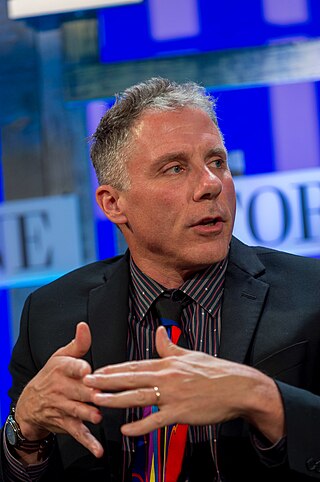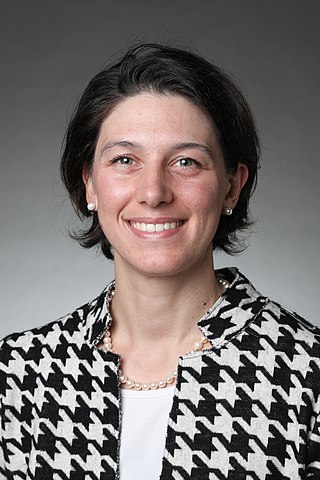Related Research Articles
Phaedon Avouris is a Greek chemical physicist and materials scientist. He is an IBM Fellow and was formerly the group leader for Nanometer Scale Science and Technology at the Thomas J. Watson Research Center in Yorktown Heights, New York.
Contact lithography, also known as contact printing, is a form of photolithography whereby the image to be printed is obtained by illumination of a photomask in direct contact with a substrate coated with an imaging photoresist layer.
Nanophotonics or nano-optics is the study of the behavior of light on the nanometer scale, and of the interaction of nanometer-scale objects with light. It is a branch of optics, optical engineering, electrical engineering, and nanotechnology. It often involves dielectric structures such as nanoantennas, or metallic components, which can transport and focus light via surface plasmon polaritons.

Harry Albert Atwater, Jr. is an American physicist and materials scientist and is the Otis Booth Leadership Chair of the division of engineering and applied science at the California Institute of Technology. Currently he is the Howard Hughes Professor of Applied Physics and Materials Science and the director for the Liquid Sunlight Alliance (LiSA), a Department of Energy Hub program for solar fuels. Atwater's scientific effort focuses on nanophotonic light-matter interactions and solar energy conversion. His current research in energy centers on high efficiency photovoltaics, carbon capture and removal, and photoelectrochemical processes for generation of solar fuels. His research has resulted in world records for solar photovoltaic conversion and photoelectrochemical water splitting. His work also spans fundamental nanophotonic phenomena, in plasmonics and 2D materials, and also applications including active metasurfaces and optical propulsion.
Scanning probe lithography (SPL) describes a set of nanolithographic methods to pattern material on the nanoscale using scanning probes. It is a direct-write, mask-less approach which bypasses the diffraction limit and can reach resolutions below 10 nm. It is considered an alternative lithographic technology often used in academic and research environments. The term scanning probe lithography was coined after the first patterning experiments with scanning probe microscopes (SPM) in the late 1980s.

Surface plasmons (SPs) are coherent delocalized electron oscillations that exist at the interface between any two materials where the real part of the dielectric function changes sign across the interface. SPs have lower energy than bulk plasmons which quantise the longitudinal electron oscillations about positive ion cores within the bulk of an electron gas.
A nanolaser is a laser that has nanoscale dimensions and it refers to a micro-/nano- device which can emit light with light or electric excitation of nanowires or other nanomaterials that serve as resonators. A standard feature of nanolasers includes their light confinement on a scale approaching or suppressing the diffraction limit of light. These tiny lasers can be modulated quickly and, combined with their small footprint, this makes them ideal candidates for on-chip optical computing.
A plasmonic-enhanced solar cell, commonly referred to simply as plasmonic solar cell, is a type of solar cell that converts light into electricity with the assistance of plasmons, but where the photovoltaic effect occurs in another material.

Thermal scanning probe lithography (t-SPL) is a form of scanning probe lithography (SPL) whereby material is structured on the nanoscale using scanning probes, primarily through the application of thermal energy.

The superconducting nanowire single-photon detector is a type of optical and near-infrared single-photon detector based on a current-biased superconducting nanowire. It was first developed by scientists at Moscow State Pedagogical University and at the University of Rochester in 2001. The first fully operational prototype was demonstrated in 2005 by the National Institute of Standards and Technology (Boulder), and BBN Technologies as part of the DARPA Quantum Network.
Vasily Astratov is a full professor of Physics and Optical Science at the University of North Carolina at Charlotte. He became known for launching synthetic opals as new self-assembled photonic crystals for visible light in 1995 in his former group at Ioffe Institute in Russia. This work has resulted in a quest for inverse opals with a complete three-dimensional photonic band gap
Richard Magee Osgood Jr. was an American applied and pure physicist. He was Higgins Professor of Electrical Engineering and Applied Physics at Columbia University.

Plasmonics or nanoplasmonics refers to the generation, detection, and manipulation of signals at optical frequencies along metal-dielectric interfaces in the nanometer scale. Inspired by photonics, plasmonics follows the trend of miniaturizing optical devices, and finds applications in sensing, microscopy, optical communications, and bio-photonics.
A nanophotonic resonator or nanocavity is an optical cavity which is on the order of tens to hundreds of nanometers in size. Optical cavities are a major component of all lasers, they are responsible for providing amplification of a light source via positive feedback, a process known as amplified spontaneous emission or ASE. Nanophotonic resonators offer inherently higher light energy confinement than ordinary cavities, which means stronger light-material interactions, and therefore lower lasing threshold provided the quality factor of the resonator is high. Nanophotonic resonators can be made with photonic crystals, silicon, diamond, or metals such as gold.

Dieter Pohl is a German–Swiss physicist. He became known especially for his pioneering works in nano-optics, near field optics (NFO), and plasmonics.
Plasmon coupling is a phenomenon that occurs when two or more plasmonic particles approach each other to a distance below approximately one diameter's length. Upon the occurrence of plasmon coupling, the resonance of individual particles start to hybridize, and their resonance spectrum peak wavelength will shift, depending on how surface charge density distributes over the coupled particles. At a single particle's resonance wavelength, the surface charge densities of close particles can either be out of phase or in phase, causing repulsion or attraction and thus leading to increase (blueshift) or decrease (redshift) of hybridized mode energy. The magnitude of the shift, which can be the measure of plasmon coupling, is dependent on the interparticle gap as well as particles geometry and plasmonic resonances supported by individual particles. A larger redshift is usually associated with smaller interparticle gap and larger cluster size.
Diana Huffaker FIEEE, FOSA is a physicist working in compound semiconductors optical devices. She is the current Electrical Engineering Department Chair at the University of Texas at Arlington. Previously, she served as the Sêr Cymru Chair in Advanced Engineering and Materials and as Science Director of the Institute of Compound Semiconductors at Cardiff University. Her work includes compound semiconductor epitaxy, lasers, solar cells, optoelectronic devices, plasmonics, and Quantum dot and nanostructured materials.

Igor V. Minin, a Russian physicist, corresponding member of the Russian Academy of Metrology and a full professor of Physics at the Tomsk Polytechnic University. He became known for contribution to the creation of new directions in science: THz 3D Zone plate, Mesotronics, subwavelength structured light, including acoustics and surface plasmon.

Giulia Tagliabue is an Italian engineer specialized in nanophotonics. She is a professor at EPFL's School of Engineering, where she leads the Laboratory of Nanoscience for Energy Technologies (LNET).
Kirsten E. Moselund is a Danish engineer who is a professor of electronics and microtechnology at École Polytechnique Fédérale de Lausanne. She also leads the Laboratory for Nano and Quantum Technologies at Paul Scherrer Institute. She previously worked as Head of the Materials Integration and Nanoscale Devices group at IBM Research.
References
- ↑ Personal page on AMOLF website. Accessed January 8, 2009.
- ↑ Personal page on alternative AMOLF website Archived 2009-05-15 at the Wayback Machine . Accessed January 8, 2009.
- ↑ PDF version of 1991 publication on Optical Doping Archived 2011-07-24 at the Wayback Machine . Accessed January 8, 2009.
- ↑ News release on AMOLF website Archived 2011-07-16 at the Wayback Machine . Accessed January 8, 2009.
- ↑ "Albert Polman". Royal Netherlands Academy of Arts and Sciences. Retrieved 30 July 2015.
- ↑ "Albert Polman - AMOLF". AMOLF. Retrieved 2017-02-02.
- ↑ BV, DELMIC. "About us | DELMIC". www.delmic.com. Retrieved 2017-02-02.